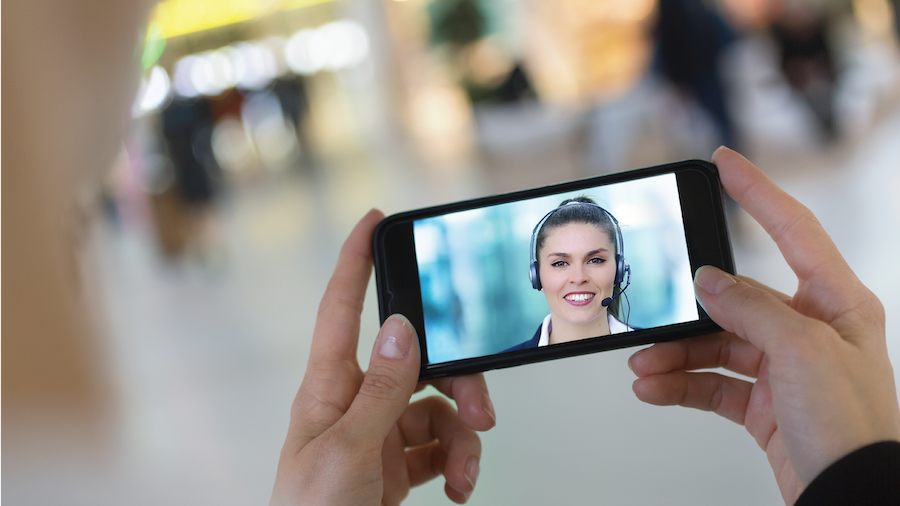
Consumers live in an on-demand world and live digitally whether they are on their mobile device, using their computer, or interacting with kiosks public places, including retail stores.
As disruption continues with the continuing growth of amazon.com and other massive e-commerce marketplaces, with competitive prices and nearly instant delivery, retailers are challenged to compete with customer experiences that not only surprise and delight but facilitate the shopper’s journey.
Here’s an example.
A couple is in the market for a large screen smart TV, and heads to the mall to do some competitive shopping, after reviewing their options on the web.
They head into a Big Box store on a busy Saturday evening, and with a huge number of shoppers, and not enough sales associates to go around, they are left to their own devices to study each of the options, and to try and understand what a “Smart TV” really means.
They have lots of questions but are unable to find anybody who can help them, but they take a few photos and head to a restaurant for dinner, discuss their options, then start a web search for the TV’s they liked the most. By the time they get to dessert, they have ordered a TV on amazon.com, saving money, and saving the hassle of having to either fit the carton into their car, or paying for delivery.
The following day, the TV is delivered, and the Big Box store lost a customer they may not have even known they had.
Everybody loses, except the consumer and Amazon, who is taking 30% margin without having to pay for expensive retail space or staff, and who doesn’t even have to warehouse the products depending on the deals they cut with suppliers.
Fast forward to a new future for physical retailers (who are also online retailers) who can serve customers better with this one, simple innovation. And rewind to this Saturday night shopping trip.
Instead of relying on sales associates in the store, the Big Box retailer could have offered an instant expert – in the specific product category – virtually appearing on a screen in the store – or on the customer’s smart phone.
How?
Snap a QR code, and instantly be connected to an expert – one who can provide advice on a number of options, or one who could even be provided by the original supplier – let’s say in this case Samsung. Just as Samsung already pays Big Box stores for shelf space and sales data, they could pay to have virtual human experts to create amazing, competitive experiences which not only sell more TVs, but please customers with real time support, and can sell additional related products and services (for example, a sound bar and a mounting kit, a service policy and installation).
Amazon.com doesn’t offer this level of personalized, friendly service – but the Big Box retailer and their vendor partners can, simply by setting up contact center cloud technologies, routing and applications that turn a frustrating experience into a profitable and happy moment all around.
Here’s another example, which we’re already seeing in place today. Using kiosks around retail department stores, customers can scan and item they want, but in another color or another size. With “self-service” a customer can find and order that item to be shipped to the store or their home, but with a virtual human agent, that customer can also get advice on what to pair that item with. Sales associates can be met throughout the store, and through thousands of stores, and those human interactions can be as satisfying as in-person experiences, especially since the virtual associate has more data available, guidance, coaching and brand training. The retailer can gain enormous insight into the physical shopping experiences, behaviors and more, and continually shape better and more competitive offerings and get a true advantage compared to their traditional and disruptive challengers.
A third example is the ability for a customer to “visit” a physical store, but online. We love what Toy Genius has innovated; they provide a means for their customers to come to one of their toy stores online, and be walked around the store with a Toy Genius (their name for a sales associate) who can provide advice to the Aunt who has no idea what her 12 year old nephew wants for his birthday. The Toy Genius can help find the product, wrap the product and ship the product, while co-browsing with the customer – including helping them complete their purchase. Here’s a video showing the experience – an excellent example of how innovation helped this women-owned small business compete against the giants, not by reducing prices, but improving service.
By merging the digital and physical worlds with CX innovations, retailers can create valuable customer experiences, driving sales and securing loyal and engaged customers.
We’d love to hear your ideas about how the physical and digital shopping experience can be improved – for the benefit of all participants, but mainly the customers who truly appreciate great moments and not just sterile transactions.